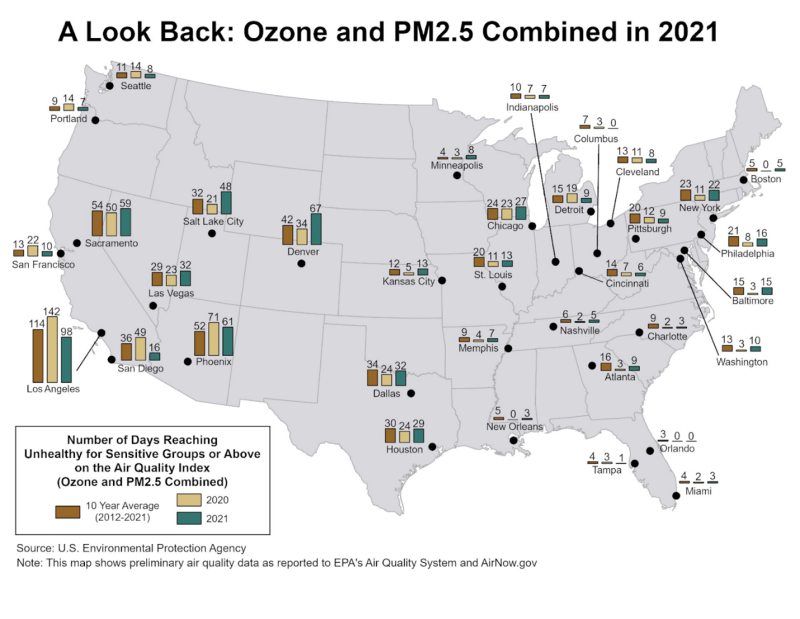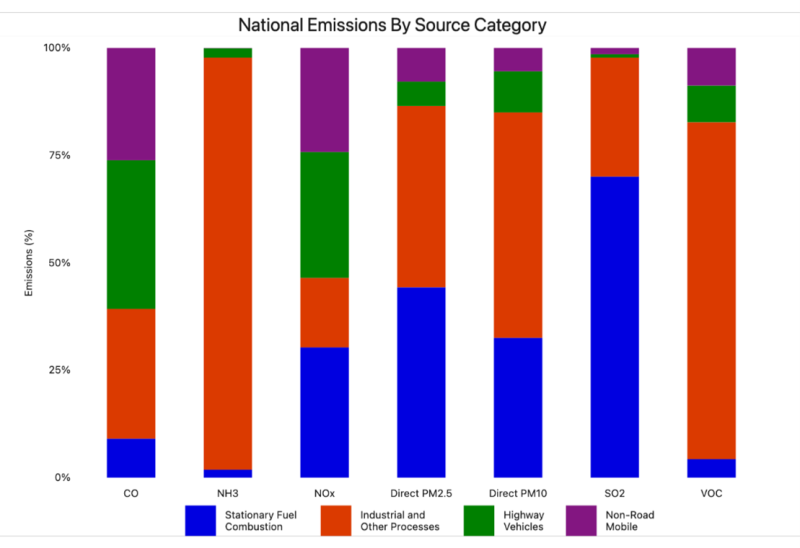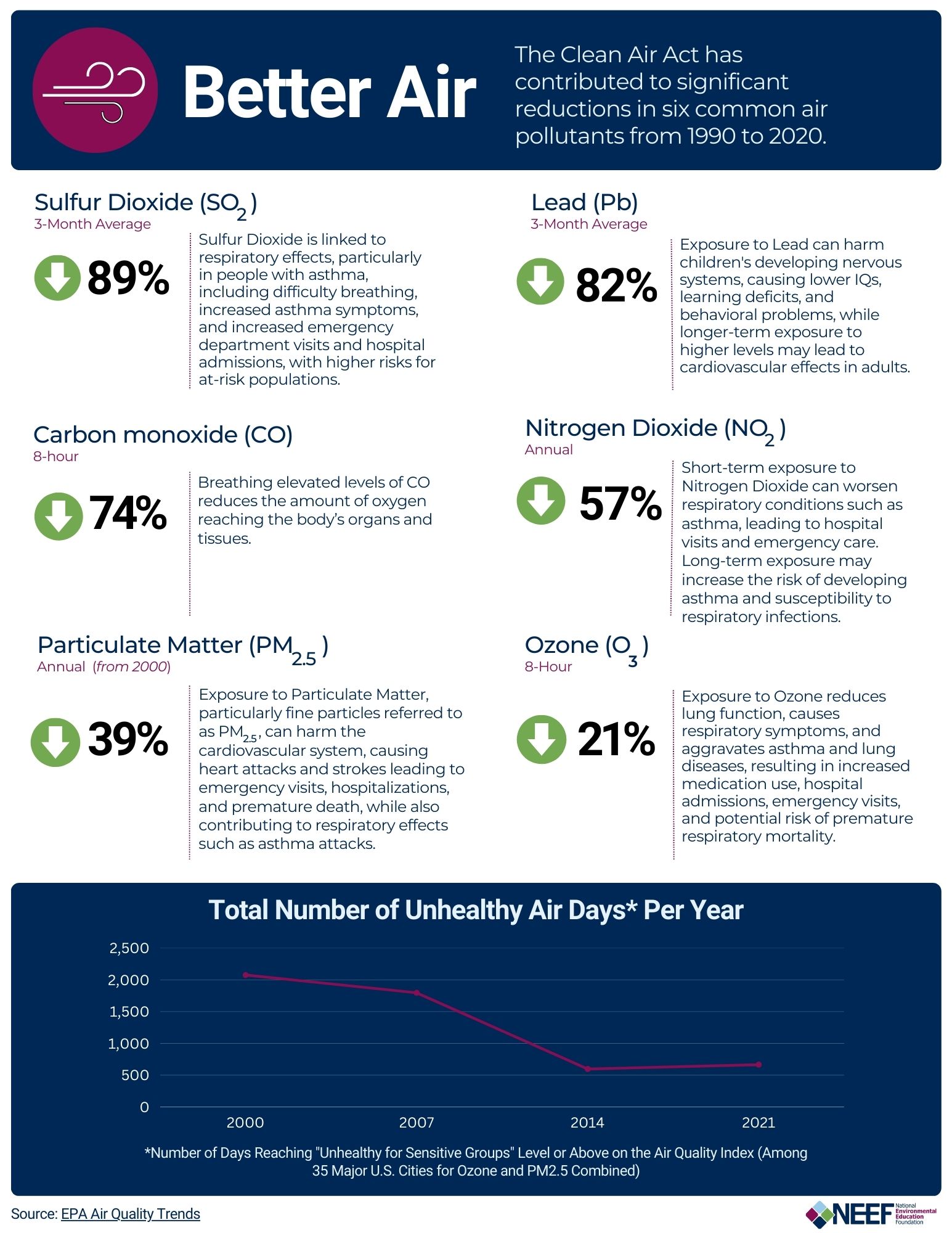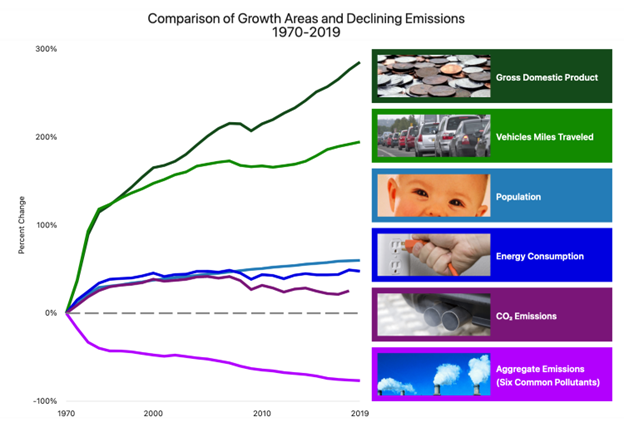
What Makes Air Healthy?
Fresh air. You know it when you smell it—but do you know what actually makes air “clean?”
Clean air contains a naturally occurring balance of gasses, including nitrogen and oxygen, without harmful levels of pollutants or contaminants. It is safe to breathe.
The US Environmental Protection Agency (EPA) tracks the nation’s air quality. The latest data shows that, overall, our air is significantly cleaner than it was in 1980. That’s good news since each of us breathes in over 3,000 gallons of air every day.
However, there is still more work to be done to reduce air pollution and ensure all communities have access to healthy, clean air. In 2021, approximately 102 million people lived in US counties with pollution levels higher than the National Ambient Air Quality Standards (NAAQS) set by the EPA.

Threats to Clean Air
Air pollution is a mix of hazardous substances from both human and natural sources, including:
- Stationary fuel combustion sources like electric utilities and boilers
- Industrial processes like smelters, kilns, and refineries
- Cars and trucks
- Other vehicles such as recreational and construction equipment, airplanes, trains, and boats
- Natural sources like smoke from wildfires, volcanic eruptions, and methane from decomposing organic matter
Sometimes, air pollution can be easy to spot, like exhaust spewing out of a tailpipe or a brown haze lingering in the air over a city. Other times you can smell it but not see it. And sometimes it can’t be detected without special equipment.

Six common air pollutants—referred to as “criteria pollutants” by the EPA—include:
- Carbon monoxide (CO)
- Lead (Pb)
- Nitrogen dioxide (NO2)
- Ozone (O3)
- Particulate matter (PM)
- Sulfur dioxide (SO2)
Hazardous air pollutants known or suspected to cause cancer or other serious health problems like birth defects are classified as “air toxics.” Breathing in these chemicals can result in eye, nose, and throat irritation in the short-term and serious damage to pulmonary and respiratory systems in the long term. Examples of air toxics include:
- Asbestos
- Benzene, found in gasoline
- Methylene chloride, a common solvent

Why Clean Air is Important
Air pollution is a major health threat. It is responsible for approximately nine million deaths per year—one in six deaths worldwide. Air toxics increase the risk of cancer for millions of people in the US. Those facing the biggest risks often live in urban areas near multiple emission sources, such as industrial facilities and major roadways.
Depending on the type of pollutant, certain groups of people including older adults, children, and those with heart or respiratory diseases such as asthma are most at risk of experiencing adverse health effects from poor air quality. Air pollution is a common environmental risk factor in communities that face health inequities.
Pollution also has a big effect on the environment we live in. Climate change and air quality are linked. Some sources of poor air quality also contribute to climate change, like burning fossil fuels. Climate change, in turn, can make air quality worse by resulting in heat waves and increased ground-level ozone pollution. Extreme weather conditions due to climate change also puts people’s health and well-being at risk.
How Does the EPA Protect Air Quality?
The EPA takes action to ensure that all Americans are protected from air pollution. It sets limits on how much certain pollutants can be in the air anywhere in the United States. The EPA can also limit emissions of air pollutants from sources like utilities and factories.
Individual states and tribes can not have weaker pollution limits than those set by the EPA. The EPA supports state, tribal, and local governments with research, engineering, and funding to help them make progress toward clean(er) air.
Federal authority for the EPA’s work on air quality dates back to the 1950s. Important air quality milestones include:
- Air Pollution Control Act of 1955: The first federal air pollution legislation funded research on air pollution.
- Clean Air Act of 1963: Authorized the development of a national program to address air pollution related to environmental problems.
- Air Quality Act of 1967: Established rules for the interstate transport of air pollutants.
- Clean Air Act of 1970: A major shift in the federal government’s role in air pollution control, this legislation authorized the development of comprehensive federal and state regulations to limit emissions from both industrial and mobile sources like cars and trucks. Four major regulatory programs were initiated, including the NAAQS. The EPA was created on December 2, 1970, to implement the new standards.
- Clean Air Act Amendments of 1977: Set rules to help geographic areas meet the NAAQS.
- Clean Air Act Amendments of 1990: Increased the authority and responsibility of the federal government to control 189 toxic pollutants and created a program to phase out the use of chemicals that deplete the ozone layer.
On the 50th anniversary of the Clean Air Act, the EPA reported that emissions of six key pollutants dropped by 77% between 1970 and 2019, while the economy grew by 285% during that time. New passenger vehicles and heavy-duty trucks are 99% cleaner for most tailpipe pollutants compared to the 1970s when the EPA first began setting emission standards.

How You Can Help Reduce Air Pollution
While overall emissions and pollution levels are substantially lower than in the past, air pollution is still a serious problem in many communities—especially those in urban areas, near industrial facilities, or in areas with high emissions from transportation. Pollutants come from many different sources and can travel long distances across state lines.
We can all help address the challenging problem of air pollution. Protect the air we all breathe by taking action:
- Conserve energy. Turn off appliances and lights when you leave the room, wash your clothes in warm or cold water instead of hot, and recycle bottles and cans.
- Look for the ENERGY STAR label when buying home or office equipment.
- Choose efficient, low-polluting models of vehicles.
- Use public transportation, walk, or ride a bike when possible.
- Keep your wood stove or fireplace well maintained and use best practices for wood-burning to minimize smoke.
You can learn more by making plans to celebrate Air Quality Awareness Week on May 1-5, 2023. The EPA and other federal, state, and tribal partners will explore the theme “Working Together for Clean Air” to increase air quality awareness and help people incorporate air quality knowledge into their daily lives.


